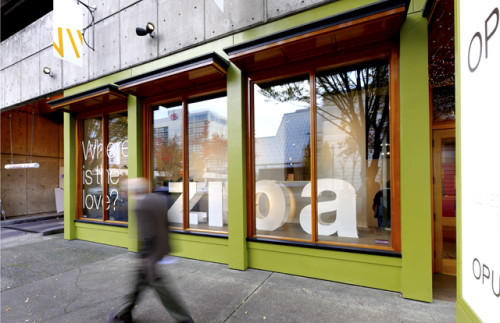
The Story of Ziba
Ziba, Portland, Oregon, Portland, Oregon, 2010
Description
Project brief: In this case, the client was ourselves. Ziba was invited in the summer of 2010 to create an exhibition at the OPUS VII gallery in Eugene, Oregon, a college town two hours south of our Portland headquarters. The exhibition had to tell a clear story about the design process to an audience with little familiarity with the creative professions and open a window into Ziba’s specific process and achievements.
Primary challenges included a budget of just $10,000 for a 2,000-square-foot space; a six-week turnaround from concept to opening; and taking an objective step back to present our own work in a way that’s accessible to the casual visitor.
Approach: An architect, graphic designer, interaction designer and copywriter worked together with the creative director to pursue a three-part approach to the exhibit. Because visitors would be unfamiliar with design processes, one wall would broadly explain the steps used in a generic design project, from research to concept to final production. Next, the main gallery floor would display specific case studies, using images, descriptions and physical artifacts to tell the stories of three Ziba projects from the past decade. Finally, a “project wall” would invite viewers into the room where the designers do their work, using a vast collage of sketches, research and strategy papers, renderings and other documents from a client project currently in progress. The overall effect was of a Ziba pop-up studio flinging its doors open to the public.
Details of how to present all this information were left to the internal team, with the understanding that anything they conceived would need to be built and installed using internal resources.
Effectiveness: Design studios rarely get the chance to describe their process and value to anyone besides clients and fellow creative professionals. This is unfortunate, for both external and internal reasons.
Externally, telling a design story to non-designers casts light on the impact of design on daily life in general. In this sense, the exhibition was an unqualified success, drawing strong attendance upon opening and throughout its two-month run, and impressing the story of Ziba and the broader design professions on thousands of people who would have never been exposed to such information. Local papers wrote it up alongside more familiar art openings, and community members discussed it online and on campus. The direct impact of such exposure on business development is impossible to calculate, but the broader cultivation of design sensitivity is certain, and undeniably positive.
The impact on the OPUS VII gallery and Eugene’s educational, artistic and business community would be hard to overstate. Kazem Oveissi, the owner of the gallery, wrote the following assessment after the exhibition’s close:
“I think one of the amazing results of the show was the extraordinary attendance by the faculty and students from the University of Oregon and Lane Community College. As you might imagine, U of O (a big university in a small town) is, in a way, in its own bubble and quite isolated from the rest of the community. The only way we could get participation and collaboration is when we have unique contents and a sophisticated presentation. Ziba, successful on both counts, was really a hit. And the attendance wasn’t just from the School of Architecture & Allied Arts and their product-design department but also from students and faculty of the business school. I had a professor from the business school visiting two days in row preparing for a talk about Ziba for his class. We also had more visitations from middle- and high-school teachers and students. The show was a wonderful surprise, and had a unique intrigue for the general public as well. Moreover, Ziba’s doing an exhibit in Eugene—again a very small market—was instrumental for us in securing another great exhibition, this time in transportation design by Boeing, showcasing their new 787 Dreamliner. Ziba has definitely raised the bar for OPUS and we thank you for that.”
Of equal value was the chance for Ziba to define our achievements and process to ourselves. By taking on a clearly constrained introspective task, we were forced to distill our story down to something much more direct than our internal discussions. The lessons we learned about our own process and offerings have aided subsequent client-facing and marketing work immeasurably.
Because of cost constraints, the exhibition was completed at minimal cost, relying heavily on Ziba’s own internal shop for most printing and fabrication, and on Ziba’s designers to paint graphics and install fixtures. There are no measurable sales or return on investment on an exhibition of this sort, but it was completed with the greatest possible efficiency.
Because of its nature as a communication effort, the social engagement and response created by the exhibition was a key part of its success.
Several small decisions contributed to a reduced environmental impact for the project. In-house fabrication of many fixtures meant a minimum of wasted materials. Many of the artifacts and documents on display were repurposed from Ziba’s main Portland office. Most significantly, we chose to forgo a large vinyl graphic covering one wall in favor of sending two employees to hand-paint the graphic, demanding greater effort but far less waste.
By its prominent presence in a storefront gallery in downtown Eugene, the Ziba exhibition was viewed by far more people than just its target audience. This fact, combined with the shift in local perception of what could be exhibited in an art gallery, contributes significantly to local awareness of and curiosity about the design professions.
Credits
- Design firm
- Ziba, Portland, Oregon
- Creative director
- Chelsea Vandiver
- Art director
- Jon Irick
- Designers
- Heather Cummings, Yoshiko Shimono
- Photographer
- Stephen A. Miller
- Writer
- Carl Alviani
- Producers
- CJ DeWaal, Paul Petri
- Project manager
- Niki Diamond
- Fabricators
- The Imagine Group, Northwest Foam
- Client
- Ziba






